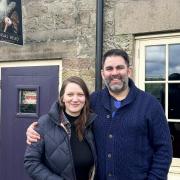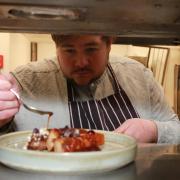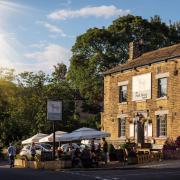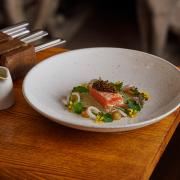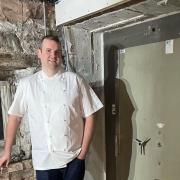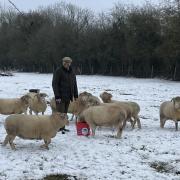They say good things come to those who wait. In the case of producing an artisan whisky packed with provenance, flavour and craftsmanship, it’s undoubtedly true.
So, when the first bottles of Wire Works Whisky hit the shelves this month, glasses will be deservedly raised to the hard work behind the scenes at the White Peak Distillery.
The story begins in 2016 when, having moved out of London to rediscover their childhood roots, distillery co-founders Max and Claire Vaughan spotted an opportunity to create Derbyshire’s first single malt.
A cocktail of passion mixed with a leap of faith has seen the couple achieve this long-held dream.
After entering through the distillery shop and tasting room – which thanks to Claire’s eye for design successfully marry industrial chic with cosy hygge – the first stop on a tour of the whisky production line is the hopper.
Here, a combination of English unpeated and peated malted barley is crushed in readiness for the watery depths of the masher.
Charged with keeping a close eye on the heat-induced conversion of the barley’s starch to sugar, is experienced distiller, Dave Symes.

‘When ready, this wort, as it’s called, is moved into tanks and cooled down from 65 to 20 degrees,’ explains Dave.
‘The temperature preserves enzymes that improve the alcohol yield, and keeps some of the bacteria to aid flavour development during fermentation.
‘We then add two types of yeast: a powdered yeast which does the bulk of the work, then a second which is a bit more interesting - a live brewer’s yeast used to make Thornbridge Brewery’s Jaipur Bitter.
‘We go over and pick up around 50 litres of yeast each week and by adding this to our fermentation tank it enhances the final whisky’s flavour.’
In their desire to make Wire Works Whisky stand out from the crowd, this tie-in with the Bakewell brewery makes perfect sense.
‘We wanted to create this link between Derbyshire’s first whisky and a brewing heritage that goes back over 300 years,' explains Max.
'Yeast is a waste product in beer making and Thornbridge can provide us with a constant supply.’
After a four-day fermentation, it’s the alchemy taking place within the two giant copper stills, specially made in Scotland to their own design, that raises the bar at this distillery.
Whilst Dave ensures the steam-powered equipment keeps the precious liquor on a rolling boil, the alcohol vapour condenses within each still until the desired concentration is reached. Resulting, after 48 hours, in a barrel of whisky with complex, fruity notes.

Side-stepping the busy bottling and labelling plant, it’s the barrel room that’s up next where, as he demonstrates, more tweaks can be made to add variety to the whisky during aging.
‘We principally fill two different types of cask here: a Bourbon cask and a red wine cask,’ describes Dave.
‘The Bourbon cask is made from American oak and gives the whisky a vanilla flavour. The longer it sits in the cask the more the flavour.
‘The ex-Rioja wine casks have been through a process of toasting and re-charring, making it easy for the alcohol to extract flavour and colour from the wood at an accelerated rate. The whisky will taste quite different depending on the cask used.’
As Dave goes on to reveal, there’s an added benefit derived from another of the distillery’s spirit lines.
‘We also produce our own aged rum here which is kept in a barrel for a year. As soon as the rum has been bottled this cask is available to use, enabling us to produce a rum finished whisky. There are not many distilleries where the whisky has been produced in the same place as the rum.’
This is precision work which, Max admits, has taken numerous experimental runs to get right. Inevitably, there have been factors outside of their control.
The area’s 2019 floods severely disrupted access to the site, whilst the popular face-to-face visitor experiences disappeared overnight with the arrival of the pandemic.
Not to be thwarted, Claire says the small team pulled together, responding to the setback by launching virtual tastings, to great effect.

‘These tastings allowed us to talk directly with our potential whisky audience and reach people further afield, including Europe.’
Meanwhile, thanks to a £1.3m crowd funding campaign, not only were extra staff recruited last year to ramp-up production and sales, just as valuable was the word of mouth generated - so much so that even before the whisky’s official launch, 4,000 of the 5,000-plus bottles available had been reserved.
‘Our target is to produce between 15,000 and 18,000 bottles of whisky this year, from 11 releases planned for 2022,’ reveals Max.
With trade partners across the UK, as their first shipment of several hundred bottles leaves for north of the border, the significance of this is not lost on Claire.
‘People are becoming more open to the idea of whisky made outside Scotland. Because we can’t wait for our whisky to mature for 12 years, we focus on how to create that flavour without relying on the cask to do all the work.
‘We’re never going to take on the Scots in production capacity, however it’s nice there’s an interest for English whisky.’
Naturally, they’ve kept a couple of bottles of February’s landmark release back for themselves. The distinctive blown glass ribbed design, customised under Claire’s direction, yet another nod to the buildings’ heritage.
‘Both Max and I are really proud to have got to the stage, after three years, of having whisky in a bottle,’ she says. ‘We’re excited about the future.’
The full interview will appear in the March edition of Derbyshire Life magazine, due out March 25.
Words by Viv Micklefield







